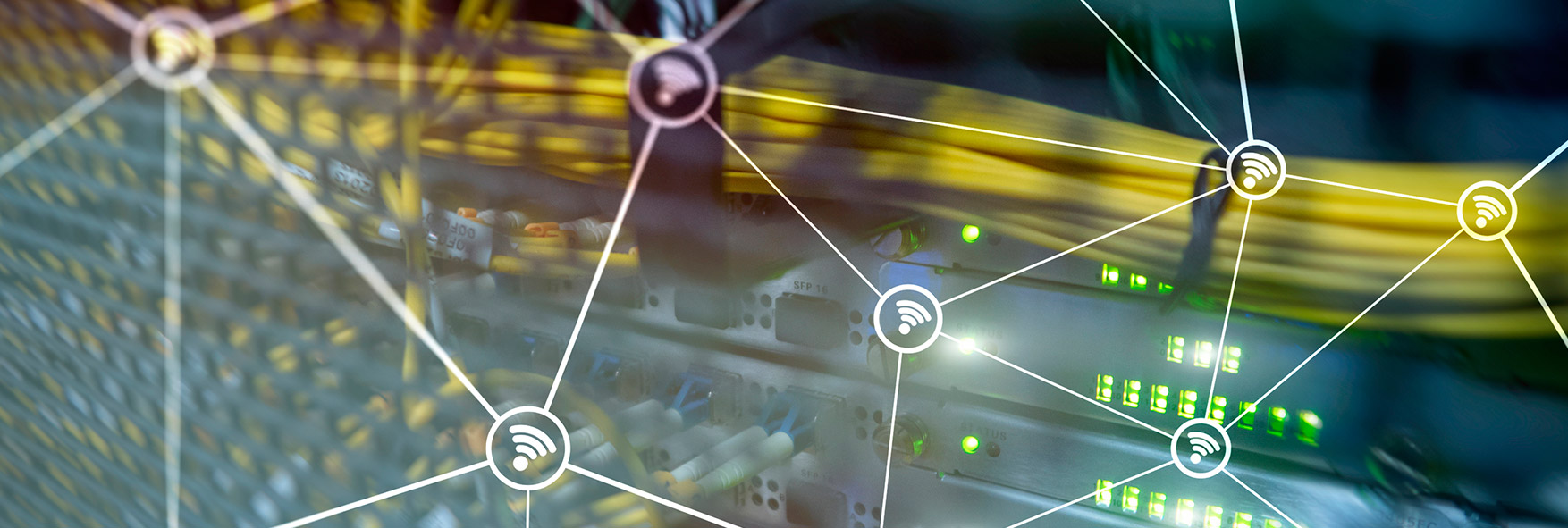Stakeholders
MAP OF CELLNEX STAKEHOLDERS
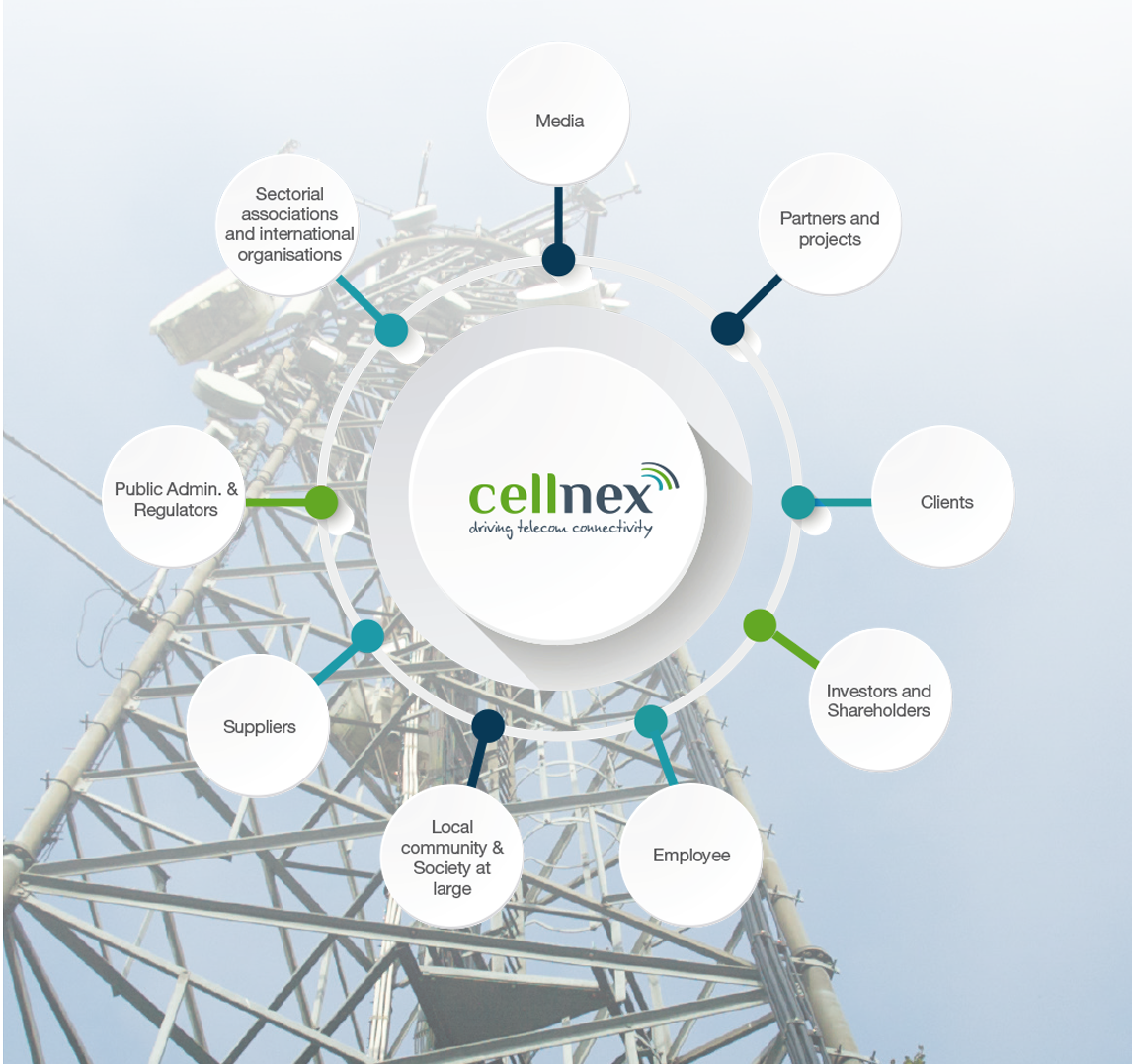
People management
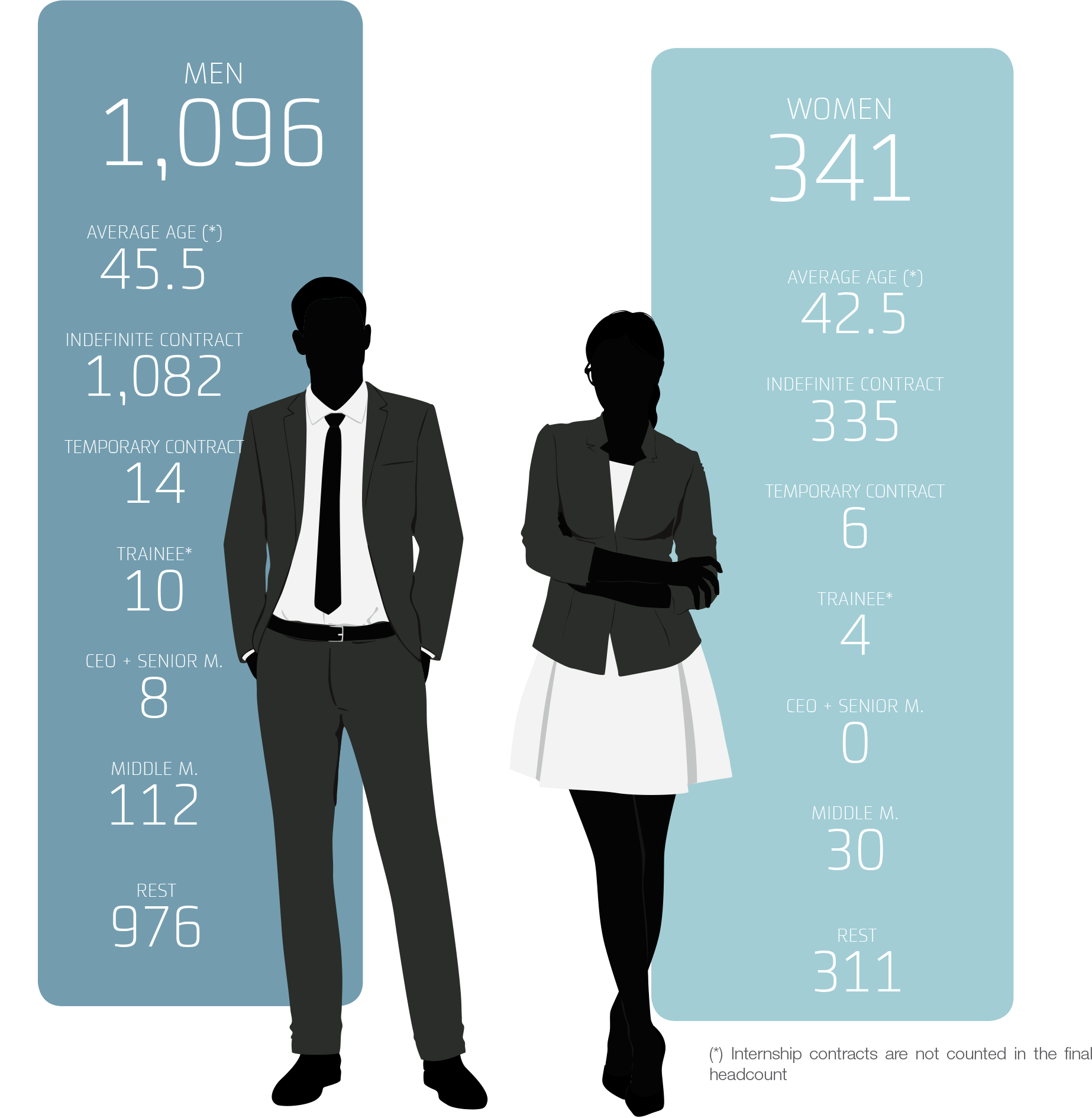
The Cellnex team consists of 1,437 people, distributed geographically in Spain (84%), Italy (9%), France (2%), the Netherlands (2%), the United Kingdom (1%) and Switzerland (2%). This multidisciplinary team is key to a successful business project, which enables Cellnex Telecom to be one of the main telecommunications infrastructure operators in Europe.
The workforce is predominantly male, reflecting the current situation of the sector.
Staff numbers of Cellnex France and Cellnex Switzerland increased considerably as they completed their process of formalising the team.
Specifically, in Cellnex France, the workforce went from 21 to 34, a 62% increase from 2017. Furthermore, Cellnex Switzerland has experienced almost 156% growth compared to the first year.
In 2018, the staff turnover rate in Spain remained constant at 0.08%.
Equality, inclusion and diversity and integration
| Significant milestones in 2018 | Main challenges for 2019 |
| Renewing the Equality Plan (Retevisión and Tradia): assessing the degree to which equal opportunities have increased at Cellnex | Developing the Equality Plan and meeting the objectives set at four years |
| Starting the pilot tests on teleworking | Developing and analysing the pilots in order to roll this out to all employees |
| | Working together with Futureway on inclusion issues to try to incorporate students at risk of social exclusion |
| | Developing a diversity and inclusion programme |
Cellnex welcomes and respects staff diversity in the broadest sense of the term, with equal consideration for gender, race, ethnicity, origin, age, sex, religion, opinion, and any other condition or social circumstance of any employee.
In 2018 the company continued to work on renewing its Equality Plan, applicable to the Spanish subsidiaries Retevisión and Tradia, which began in 2017 with an independent external diagnosis of the extent of equality opportunities in Cellnex. The results were used to devise and launch Cellnex’s Second Equality Plan in 2018, which has a duration of four years.
The general objective of this plan is to progressively increase the number of female employees in all positions and responsibilities, guaranteeing equal treatment and opportunities for women and men and preventing sexual harassment and gender discrimination, both indirect and direct.
The actions set out in the new Equality Plan focus on a range of areas that cover almost the entire company and include recruitment, training, awareness-raising and work/life balance.
Moreover, the Monitoring and Evaluation Committee will evaluate the Equality Plan annually to examine compliance with the measures adopted in the Plan, assess whether the measures are appropriate, and to check they are in line with the objectives initially proposed.
In accordance with the Equality Plan, we have begun an analysis of fairness within the Corporation to compare whether pay conditions are equivalent for women and men in each job category. This analysis will be extended to the countries during 2019.
Furthermore, this year Cellnex Spain and Cellnex Italy worked on devising a remote working project to boost employee efficiency, work/life balance and commitment.
To ensure the project is successful, two six-month pilot tests were launched involving 40 volunteer employees in each country. According to the results and lessons learned, which should be finalised by mid-2019, the company will consider whether to extend remote working to all employees, incorporating any improvements identified.
THE SPECIFIC OBJECTIVES OF THE EQUALITY PLAN INCLUDE:

Attracting, recruiting and retaining talent
| Significant milestones in 2018 | Main challenges for 2019 |
| Launching the Ignición Project, focused on attracting and detecting talent among the young talent pool (interns) | Consolidating and following up the Ignición Project, reinforcing the talent acquisition initiatives, and optimising and standardising recruitment and identification of potential in the countries |
| Performing on-boarding at the corporate level in Spain, and presenting it in Italy, France and Switzerland | Developing and implementing the recruiting and on-boarding modules and developing this latter in Italy, France and Switzerland |
| Launching a Talent Review process in Corporation and in Spain | Rolling out the Talent Review process to other countries |
| Starting to define the development profiles of Cellnex posts, as well as possible professional careers | Completing the project to define posts and professional careers |
| Defining the Succession Plan for first-line managers | Extending the Succession Plan to the rest of managers |
| Presenting the Rueda Project, focused on promoting internal mobility opportunities | Developing the Rueda Project, fostering mobility opportunities, creating pools of available talent to assign according to project, fostering employer branding, etc. |
As it strives to become a benchmark in recruiting and retaining talent, Cellnex developed a series of initiatives throughout 2018 to publicise its image as an employer, improve the process of identifying and attracting young talent, and retaining and cultivating the talent already present in the company.
Thus, the Ignition Project got underway in 2018 to identify a talent pool of young people (interns) with a view to detecting and retaining talent in the company. Diversity and gender equality are fostered from the selection process onwards under this programme.
To this end, the project sets out a series of actions and objectives split into three areas:
- Employer Branding: This aims to position Cellnex as a company in which people want to work and increase the Group’s presence in the university sector.
- Recruitment: This seeks to optimise the selection process and incorporation of young talent to be trained through their development in the company.
- Identifying potential: The aim is to standardise young talent to identify the best and create a pool of candidates to cover future vacancies in the company
Also in 2018, we implemented the on-boarding programme, which aims to streamline the adaptation and integration process of new people who join the organisation.
To evaluate talent within the company, we launched a Talent Review process in Spain and throughout the Corporation through which to position employees in quadrants according to their performance and potential (through a matrix known as 9-Box). In this way, HIPOs (High Potential) and HIPERs (High Performance) are identified and actions set in train to exploit this potential.
The forthcoming challenges of the Talent Review include developing a Risk Map to analyse the risk of talent flight, and extending the programme to the countries to standardise the processes of detecting and assuring talent throughout the company.
Furthermore, we have defined Succession Plans for the first level of Management, and in 2019 we will seek to extend this to all other levels of management.
Also, Cellnex undertook a Job Assessment Study this year to characterise the different levels of positions within the company plus the skills required to perform each position. As this assessment was underway, we performed a payment diagnosis comparing the current situation of Cellnex positions with the market. The aim was to find out where the company stood and develop new salary structures that to attract and retain talent.
The Rueda Project was presented at the end of 2018 and aims to foster and strengthen various aspects of the human resources area by working on a series of levers:
RUEDA PROJECT
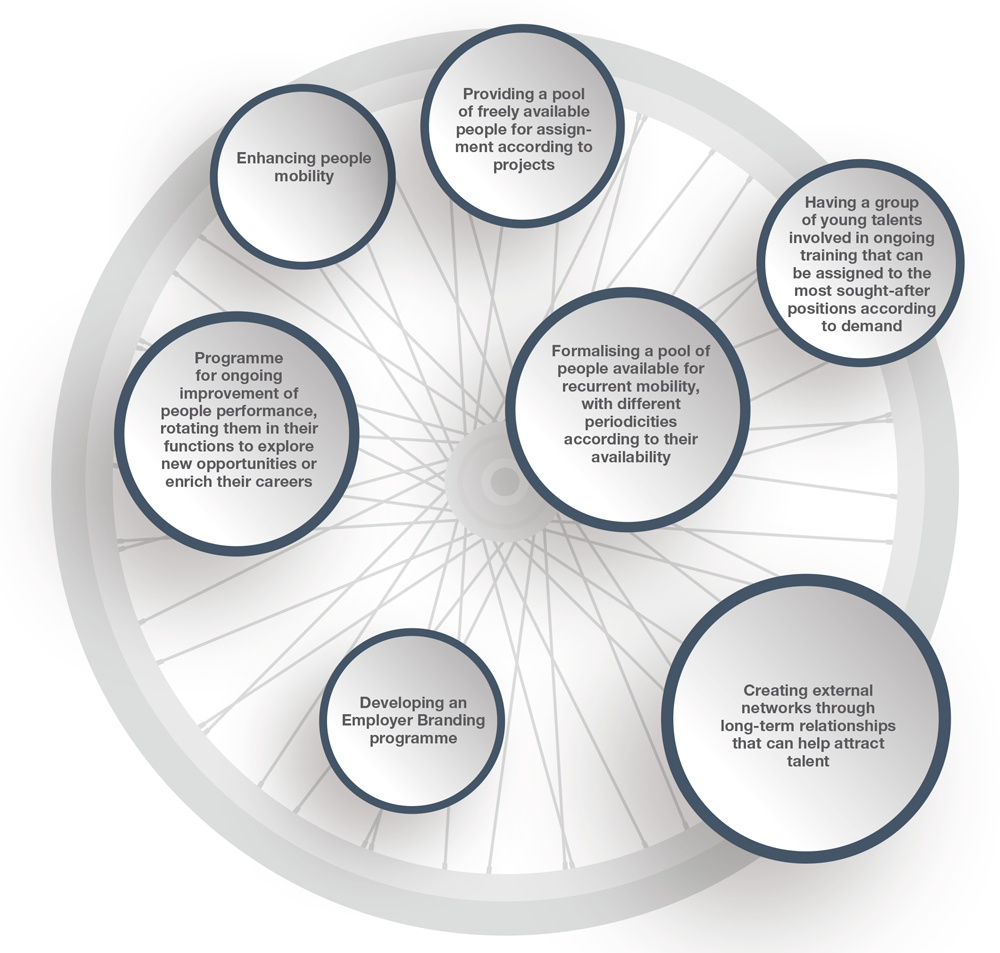
2019 will focus on developing each of these initiatives, while exploring new possibilities based on their results.
Training 2018
| Significant milestones in 2018 | Main challenges for 2019 |
| Development Dialogues launched in the Corporation, Spain and Italy | Extending the Development Dialogues to the remaining countries |
| Defining the Corporate Master's degree: scope of contents and selection criteria | Determining who will attend the Master's degree in each country and who will teach |
| Defining the new business profiles in Spain and starting in the countries | Analysing current business profiles and delivering training in countries and business lines |
As part of its mission to become a benchmark for talent management, Cellnex has performed various training actions aimed at promoting the professional development of its employees.
Thus, last year we revisited the process for the Development Dialogues (a space for dialogue between co-workers and their managers in relation to individual development of these workers), launched at Corporation and Spain level in 2017, and incorporating Italy during 2018; Likewise, open training sessions were held for employees and new managers [89]. As a continuation of this, we will seek this year to extend the process to France, the Netherlands, Switzerland and the United Kingdom.
As a new initiative that aims to provide ongoing training, we began to define a Corporate Master’s degree for employees at the end of 2018, defining its scope and establishing the criteria for selecting candidates. We expect to firm up all the details in 2019 and to begin teaching the contents to selected staff.
The corporate Master’s degree will be taught by the EADA Business School. The programme is adapted to Cellnex’s needs, starting with the Master’s degree offered by the school in open format. The participants will be drawn from the various countries in which Cellnex is present and will last for a year and a half following the attached diagram:
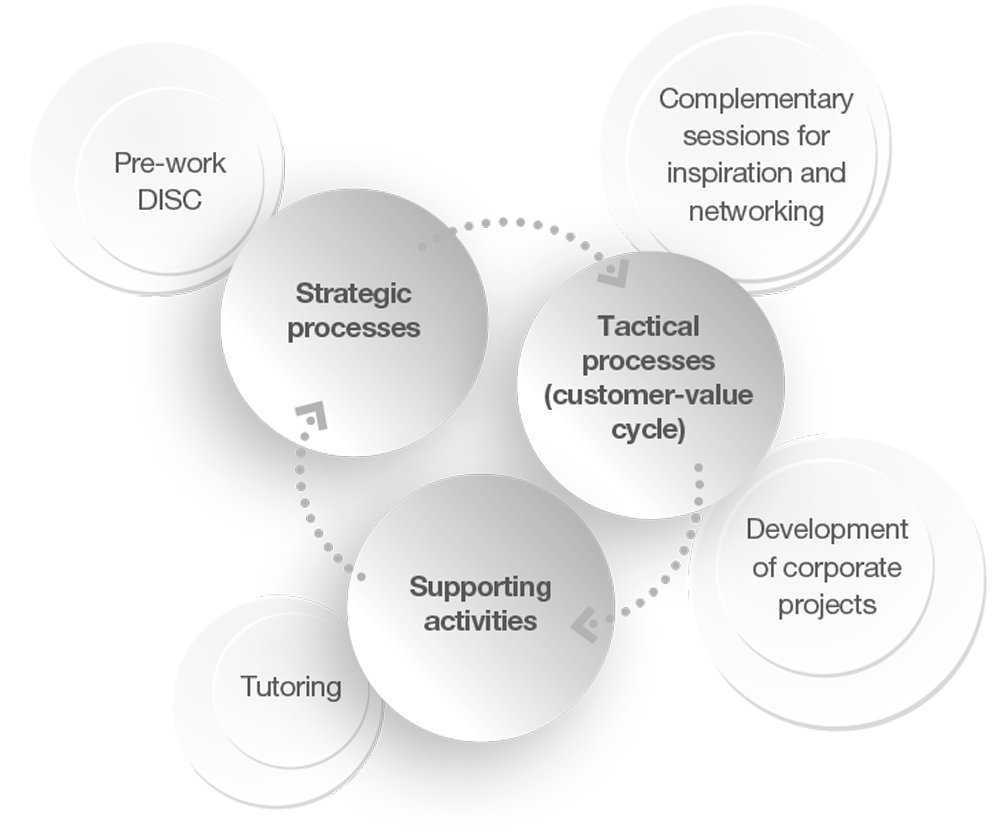
The programme will apply the Learning By doing teaching method, an active learning model by the participant: learning by doing, rather than learning by listening.
In addition, and as a result of redesigning the Commercial Model motivated by the Trinity project, a series of roles were established that are associated with the consultative sales process and account management (i.e. KAM, Product Champion, etc.), which in turn led to defining the profiles associated with each of them. The next steps involve an evaluation of the existing profiles in the countries, in comparison with the skills defined for the roles, to identify gaps and be able to carry out the necessary training actions to enhance the required skills.
Cellnex Spain continues to apply its leadership training that began in 2016 through two types of actions: training for new managers and coaching sessions for managers of various levels to boost their people management skills and increase their alignment with the leadership model. In 2018, this programme continued and was extended to new managers.
We also continued to impart technical training sessions associated with the core knowledge of the Department of each partner as well as cross-cutting training such as project management, languages, office automation, skills and Occupational Risk Prevention. Training is face-to-face, online and blended and provided by external experts and/or internal trainers.
Likewise, we continued the specific pathways aimed at project managers, internal trainers and managers, which were already underway as part of the employee training plan.
In 2018 the staff of Cellnex Spain and Italy received more than 53,315.60 hours of training, of which 5,843 were based on safety training in the workplace.
HOURS OF TRAINING
| Region | 2016 | 2017 | 2018 |
| Corporation | - | - | 5,722.03 |
| Spain | 43,501.00 | 40,452.00 | 39,721.57 |
| Italy | 2,852.00 | 4,372.00 | 6,682.00 |
| France | - | - | 1,190.00 |
| Total | 46,353.00 | 44,824.00 | 53.315,60 |
See Annex V for details.
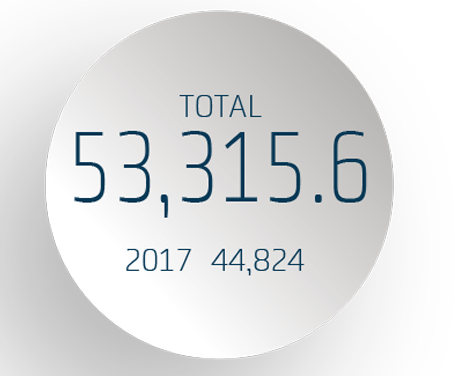
Remuneration and compensation
| Significant milestones in 2018 | Main challenges for 2019 |
| Drawing up a remuneration study, internally and as a market comparison, to establish a remuneration policy and wage brackets in line with the telecommunications market | Completing the remuneration policy and defining wage brackets, and roll-out to the rest of the Cellnex countries |
| Developing an Employee Portal, unifying all elements of employee remuneration, total compensation and social benefits | Adjusting and implementing the Employee Benefits Portal in Spain, and subsequent creation of a global portal for all employees in the rest of the countries |
In pursuit of its aim to maximise talent retention, Cellnex has developed various lines of action including an analysis of remuneration and compensation elements to optimise their competitiveness within the telecommunications market.
In this connection, we defined positions and associated profiles for all posts in the company in 2018, in parallel to which we began a remuneration study of each of these, comparing them to each other and creating a benchmark with the market. The goal of this exercise is to establish a series of competitive wage brackets for each of the professional scales and define a standardised remuneration policy to further attract and retain talent.
In parallel, we have created an Employee Benefits Portal to bring together in the same place all the elements of remuneration, compensation and social benefits that Cellnex offers its employees to make it easier to access and freely manage this information. This exercise will continue throughout 2019, until this Portal is implemented and rolled-out to all employees of the various Cellnex countries.
The professionals belonging to the Group currently enjoy a range of economic and social benefits that includes life and accident insurance, pension plans and health insurance.
Likewise, all employees of Cellnex Telecom generally have flexible hours, so they can choose when to start their working day, within a margin of hours, provided they work the number of hours established by agreement and contract by the end of the day. Likewise, all Group employees can take the holidays established by the agreement throughout the year by agreeing these in advance with the head of the department. All employees who have requested a reduction in working hours are granted this right.
Management by objectives
In Cellnex Telecom Management by Objectives (MBO) is considered as an incentive to stimulate the contribution and additional creation of value in a systematic way at all levels, ensuring a global alignment of efforts to achieve the group results expected in the market.
This array of objectives rolls out the group’s priority strategy in each country and consistently combines crossed objectives among different areas that cover the main projects of the current year to support the business strategy. In 2018 we adapted the variable remuneration system for commercial profiles throughout the organisation to encourage customer acquisition, development and management and coherence with the new Commercial Model.
One goal is to express an objective to be attained during the current year. This objective can be established by the line manager, or can be a functional objective assigned and evaluated by a cross-cutting area (resources, finances, etc.) as detailed in the Cellnex Telecom Relational Model
Each employee has different types of objective within the same period:
- Country Objectives
- Management Objectives
- Individual objectives
Occupational health and safety
Cellnex looks after well-being on its premises, striving to implement the best health and safety measures and ensuring compliance with the relevant rules in all its premises
According to the company’s Occupational Risk Prevention Policy, which lays down the guidelines for action in this area, it is incumbent upon Management to integrate and implement Occupational Risk Prevention throughout the organisation. This policy is implemented and developed through the Health and Safety Management System based on process management and continuous improvement to ensure effectiveness and efficiency. Cellnex Spain and all the companies that comprise it have the OHSAS 18001:2007 standard from the certification entity TÜV Rheinland. In 2018, following an intense reorganisation and standardisation process, Cellnex Italy, including Galata, TowerCo and CommsCon, obtained the ISO 45001 certification in Occupational Health and Safety from the certification entity DNV GL, a new international standard that replaces the OHSAS 18001:2007 standard.
OCCUPATIONAL HEALTH
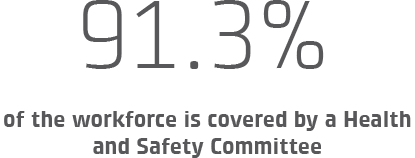
In addition, Cellnex has Business Coordination Activities agreements with its customers through which the company defines the audit processes to be made on its customers. These audit processes seek to comply with current regulations concerning occupational hazards; RD171/2004 (the Royal Decree implementing Article 24 of Law 31/1995 of 8 November 1995 on Occupational Risk Prevention, on coordination of business activities) and LPRL 31/1955 (Law on Occupational Risk Prevention).
The company also has its own operational support system (OSS) to perform exhaustive access checks at its centres, which guarantees strict compliance with the Occupational Risk Prevention Policy and with access operations involving customers and contractors.
Cellnex Spain has a Multi-Plant Health and Safety Committee which handles prevention issues affecting the company as a whole, comprising 14 members with parity between trade union and Company representatives. It also has two Health and Safety Committees, for the Barcelona and Madrid sites, which handle issues specific to the corporate buildings. In the last year, the Multi-Plant Health and Safety Committee met four times, in keeping with the legal requirement. Furthermore, there is an e-mail and a corporate Intranet application to allow any Cellnex worker to blow the whistle on any situations in which worker safety could be compromised.
Cellnex Spain complies with its prevention obligations under Royal Decree 39/1997 through a Joint Prevention Service, whereas the rest of the company has an External Prevention Service that expert suppliers provide.
Cellnex Italy has eight agreements that cover aspects related to health and safety at work.
In Spain, 91.3% of the workforce is covered by a Health and Safety Committee.
In order to ensure a safe working environment in which all company staff know the health and safety measures in the workplace, the company provides information and training in occupational health and safety for the whole workforce.
We carry out numerous communication campaigns to raise employee awareness about the importance of safety in the workplace. In addition, informative documents are available for employees on working at height and using personal protective equipment (PPE), and informative talks are held to address any queries that arise on the job.
Cellnex has an innovative application for preventing occupational risks - Cosmos Mobile, which gives real-time information on technicians’ locations and site status, allowing us to enhance employee safety as well as to maximise on the efficiency and quality of operations. In 2018 we incorporated new modules that provide information on the hazards linked to the various centres and positions, giving workers information about the characteristics of the job to be performed at all times.
In addition, and pursuant to Law 31/1995 on the Prevention of Occupational Risks, this year we performed an assessment of the psychosocial risks to which Cellnex staff are exposed in Spain, with the collaboration of the company Norprevención-Ibersys. After the initial consultation phase via questionnaire (62% response rate) and a quantitative and qualitative analysis of the results, a diagnosis was generated of the current situation of the various risk factors. To comply with this legal obligation, and also as an opportunity for the company to improve, work will be ongoing throughout 2019 to develop the Action Plan to apply the necessary preventive and corrective measures involving multidisciplinary work committees to help plan, prioritise and take part in these.
Mobility Plan
In 2018, the Cellnex Spain Mobility Plan was approved and implemented. Its primary objectives are to reduce accidents in itinere, raise awareness on preventing traffic accidents and improve the mobility of workers, partners, providers and customers. The expected outcomes are better health, energy savings, fewer emissions, and higher productivity and competitiveness.
| Actions taken in 2018 | Actions to be taken in 2019 |
| Road Safety Training | 4x4 Training and Road Safety |
| In itinere accident awareness campaigns | Online training |
| 14 Compressed Natural Gas vehicles | Road Safety awareness campaigns |
Health and Safety Training
In 2018, 5,937 hours of training were imparted at Cellnex in occupational risk prevention and occupational safety.
OCUUPATIONAL HEALTH
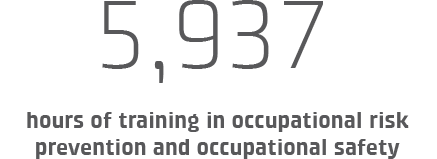
| Training provided in 2018 |
| Compulsory occupational risk prevention training |
| Firefighting |
| Cargo handling |
| Maintenance operations on carrier wave coupling devices |
| Self-protection plan |
| First aid |
| Preventive resources |
| Electrical risk |
| Work at height |
| Work in telecommunications facilities |
Accident rate
Cellnex continually monitors safety at work and strives to minimise risks and reduce incidents and accidents among employees and anyone else on its facilities.
| Spain | Italy |
| | Men | Women | Men | Women |
| Accident frequency rate (AFR) | 4.49 | 0 | 4.57 | 0 |
| Accident severity rate | 0.096 | 0 | 0.17 | 0 |
| Incidence of occupational diseases | 0 | 0 | 0 | 0 |
| Spain | Italy |
| | Men | Women | Men | Women |
| Falls on the same level | 2 | 0 | 0 | 0 |
| Falls on different level | 2 | 0 | 0 | 0 |
| Hit against object | 1 | 0 | 0 | 0 |
| Overexertion/bad posture | 3 | 0 | 0 | 0 |
| Traffic accident/initinere | 1 | 0 | 1 | 0 |
| Total | 9 | 0 | 1 | 0 |
*The rest of Cellnex regions had no working accidents
Healthy company
This year, Cellnex Spain continued working on its healthy business model. This model establishes the requirements of a management system for organisations committed to existing international principles and recommendations on healthy businesses that wish to promote and continuously protect the health, safety and welfare of their workers.
Also in 2018, Cellnex Spain worked towards adhering to the Luxembourg Declaration, which it expects to achieve in 2019. This declaration is a consensus document drawn up by the European Network for Workplace Health Promotion (ENWHP) that sets down the basic principles of action and the framework for good management of workers’ health. Participant companies undertake to put the principles of health and safety into practice in business strategies and to promote and disseminate them.
We continued making progress in this area in 2018 through various initiatives, including:
- Regular health promotion campaigns:
- Blood pressure tests, flu prevention and encouraging blood donation.
- Campaign to prevent glaucoma: the mobile unit of Tres Torres Ophthalmological Institute gave a full eye test to employees at the Parc Logístic Barcelona offices at their request and at the Ophthalmological Institute for staff from Madrid.
- Integrating health surveillance (epidemiology) to design specific campaigns on good posture, nutrition, stress management, cancer prevention, etc.
- Celebrating the World Day for Safety and Health at Work by providing fresh fruit at the vending machines in the Barcelona Parc Logístic to promote healthy eating.
- Corporate medical and physiotherapy service.
- Promoting sports among group partners who work in the central offices.
Shareholders
Cellnex works continuously to maintain investor confidence and to meet investor expectations. To this end, since 2015 the Group has had an Investor Relations Department, dedicated exclusively to channelling and making available all financial information to shareholders and analysts, as a key tool for publicising the real value and the potential of the company, plus its growth opportunities. The person in charge of this new department is Juan José Gaitán, who in 2017 was recognised by Extel 2017 in the leading European survey among the investment community, and in 2018 ranked second in the category Best IR Professional Telecommunication Services by renowned Institutional Investor Magazine.
In 2018, the Investor Relations Department, has contacted more than 325 shareholders and held meetings in 14 different countries. In 2018, 32 brokers actively hedged the shares, issuing investment recommendations on Cellnex.
Customers
Cellnex Telecom applies a customer relations model based on proximity, transparency and the search for constant improvement.
One of the key factors of the business model is continuous customer support throughout the process of providing the service, from commercial to incident management, reporting and possible consultations and complaints during provision, operation and maintenance. That is why the customer’s main contact person is the commercial manager, who involves the specialist areas required according to the service phase and characteristics, to provide a suitable response to the customer’s needs at all times.
To guarantee a personal and stable customer relationship, we strive to focus our commercial force on market segments by enhancing the role of the account manager who looks after the specialist end-to-end relationship with customers by providing a comprehensive and personalised service geared towards their overall satisfaction.
In 2018, Cellnex Spain, has handled 15 user complaints related to the DTT service. Likewise, in Italy there have been 2 customer complaints received through the suggestion box. All the complaints have been treated according to the Complaint Management Procedure of the external client and the Cellnex Telecom Company. In addition, 3,780 communications related to the DTT service (inquiries, incidents or complaints) have been attended to in the Contact Center.
As part of the effective management of significant events and incidents, there are various business continuity guidelines and plans designed to ensure that critical services can continue to be provided in the event of failure in any system, either by protecting these or by redundancy.
In Spain in 2018, the Control Centres were made into a single Network Operation Centre (NOC) with unified management, which allows us to provide a global vision for customers and to take a specialist technological approach to boost efficiency in detecting and solving incidents and problems across several geographical regions. This model ensures the possibilities of physical redundancy between sites that allows us to deal with contingency situations. As a result, we can guarantee service continuity as well as monitoring and operations, even in extraordinary situations.
The NOC operates and supervises the network 24/7 through two levels of customer service: the first level provides a broad overview to improve the service given to and perceived by customers, while the second level is split into technologies with operators who are highly skilled at each, to ensure efficiency in proactively detecting and solving incidents and problems. The equipment supporting the delivery of core services is controlled remotely from the NOC and, if necessary, can force the manoeuvres necessary for the correct provision of the service. In addition, technical units are available in all provinces of Spain so that a qualified technician can be sent to the site of the fault, when necessary, to provide a solution within the time stated in the service level agreements. Since the company provides its services and operates its network 24/7 in all locations, there is no downtime on any sites.
With the provision of new network services such as Smart Cities and IoT services, Cellnex is seeing a change in the type of its customers. Specifically, the new services entail managing a greater number of customers and players from different sectors that are also geographically disparate. This new scenario involves a change in the customer management model, which requires the implementation of new communication channels in addition to the account manager, web or email. In this new scenario it is particularly important for Cellnex to be present in forums, conferences and events in which Cellnex plays an active role.
Likewise, Cellnex has established a number of communication channels with customers, such as those contained in the service-level agreement (SLA) reports, or the studies of perceived customer satisfaction, the outcome of which feeds into action and improvement plans.
These studies were established with the following specific objectives:
- To have a complete picture of customers’ overall perception of the company.
- To learn about the level of customer satisfaction, breaking down and parametrising overall levels of satisfaction into the various values and attributes in the study.
- To produce a map of customer indicators with the services provided by the company for each activity and segmented by business area and type of customer.
- To determine company recommendation and loyalty rates relating to each service, activity, business area and customer type.
- To determine the critical points and strengths and establish an action plan based on the external customer satisfaction study.
Customer satisfaction survey
The customer satisfaction survey in Cellnex Spain is carried out on a biennial basis. The last survey was conducted in 2017 and yielded very positive results, with 92% of Cellnex Telecom customers either satisfied or very satisfied with the company’s service. Cellnex utilised the results of the 2017 survey of its most important customers to pinpoint specific initiatives for each in 2018, and devised and implemented individuals Action Plans to strengthen the company’s relationship with them. This plan is supported by a monitoring and evaluation process geared towards continuous improvements.
Furthermore, Cellnex Italy incorporated the annual customer satisfaction survey as a standard practice. The survey asks customers about their relationship with the company, the sales process, Cellnex project management, its after-sale service, administrative service, general satisfaction, and general satisfaction with other competitors on the market. In 2018, Cellnex Italy obtained 83% customer satisfaction.
Cellnex Netherlands also conducts an annual customer satisfaction survey. The results of this 2018 were broadly satisfactory, with an average score of 8.0, meaning a slight improvement compared to the results of 2017 (7.93).
Zero Outage
The Deutsche Telekom Group renewed Cellnex Telecom’s ‘Zero Outage Supplier’ certification for the second year running through Rainer Anton Offermann, Vice-President of International Network Functions in the Deutsche Telekom Technik GmbH unit. This certification is part of the German company’s worldwide programme to select and certify key connectivity service providers in each country with the aim of working jointly as partners in improving the service given to the end customer.
The programme sets the German Group’s quality standards for its customers based on the operational excellence, security and stability of the systems, monitoring of critical components and reduction / resolution of incidents with availability 24/7 by its key suppliers.
Cellnex has been working for Deutsche Telekom in Spain since 2015, providing connectivity services to T-Systems. This company of the German Group has been responsible for performing the type-approval and certification process on Cellnex based on the criteria and quality levels set by Deutsche Telekom.
LOCAL SUPPLIERS

Suppliers
Cellnex has a supplier management model based on cooperation and joint improvement. This model aims to implement more efficient procurement procedures and find technological solutions to bring about improvements, both in internal management and in providing services to customers. It should be underlined that the model is governed by the use of best practices in procurement processes.
For Cellnex it is essential that suppliers should be familiar with our corporate policies and ensure compliance with all of them. They can access our policies on purchasing, quality, the environment, occupational risk prevention, information security, corporate responsibility and R&D + innovation as well as our Code of Ethics on the Cellnex corporate website. Suppliers must comply with these requirements in the course of their work, and must also make available these rules and requirements to all contracted and subcontracted personnel.
In 2017, Cellnex drafted a Procurement Policy, which establishes and promotes a guide for action in the procurement process that goes beyond product and service price and quality to also impact social, ethical, environmental, privacy and continuous improvement aspects in the performance of Cellnex Group suppliers.
Cellnex suppliers perform important maintenance tasks and techniques, and help the company to perform its work with quality and professional rigour. Cellnex strives to generate local value by contracting 92.04% of local suppliers in Spain, 97.69% in Italy, 91.35% in France and 94.00% in Switzerland. Wherever possible, priority is given to purchasing goods and services from local suppliers, meaning from within the same country.
In terms of Occupational Risk Prevention, Cellnex Telecom establishes coordination requirements between the company and its providers of works and services, in order to comply with the obligations established in the Law on Prevention of Occupational Risks and other regulations that complement it. It has specific guidelines for suppliers that access the company’s facilities, mainly those involved in supply and maintenance projects, and customer colocation services. Likewise, Cellnex informs suppliers of the environmental requirements for works, with which it must comply to avoid generating negative environmental impacts while performing their work. If these do occur, the necessary corrective measures must be implemented to address them.
In 2018, Cellnex was part of a working group comprising the main telecommunications companies on the TELCO Training Project to provide a common training framework for the sector. The project sets the Occupational Risk Prevention training standards that all professionals in the sector must meet. It includes a list of approved training programmes and the deadlines to update theory and practical training actions, to ensure that all sector professionals have the necessary skills to perform their work. By setting out this agreement, the sector aims to systematise the training requirements required of its suppliers, improve safety in the workplace and service quality, and increase confidence and transparency.
Evaluation, selection and monitoring of suppliers
Cellnex’s companies apply a procedure for evaluating and selecting suppliers to ensure they are aligned and comply with the corporate policies and ethos.
Cellnex has a system for evaluating, selecting and monitoring suppliers that includes an internal procedure detailing the criteria and phases to be followed to become a Cellnex supplier.
- Initially, suppliers’ performance is evaluated using quality and time criteria to obtain a grading by levels according to the result obtained. For suppliers with unsatisfactory results, while there is a desire to continue the business relationship, an action plan is established to correct and adjust their service level to that required by Cellnex. If a supplier does not improve its results and is unable to make the appropriate improvements, commercial relations may be terminated. This evaluation phase covers all countries that have the SAP system for purchases, such as the corporation and Cellnex Spain and Italy, and France and Switzerland as of this year.
- In a second phase, Cellnex Spain, Italy and UK evaluate the performance of suppliers in terms of Corporate Social Responsibility including issues on ethics, the environment and labour relations. The aim of this evaluation is to ensure that the company ethos is upheld across the value chain. In 2018, Cellnex Spain has evaluated 318 suppliers in terms of labor relations and the environment, and found 5 incidents related to labour relations, all of which were minor incidents. Similarly, Cellnex Italy has evaluated 220 suppliers in terms of labor relations, without identifying any incidence. In 2019, it is planned to implement this second phase in Cellnex France.
As part of the company’s dissemination and communication of its Code of Ethics, a specific informative clause about this Code is included in the general conditions for orders in Cellnex Spain, Italy, France and Switzerland.
For the first time, and as a commitment to climate change, Cellnex participated in the CDP Supply Chain in which the company’s suppliers report data on their emissions and environmental behaviour to control and evaluate their efforts to combat climate change.
Public administration and regulatory bodies
Cellnex Telecom maintains a close relationship with the various public administrations in Spain and throughout Europe.
As an Operator with significant market power (SMP) for the broadcast carrier service of the television signal in Spain, Cellnex is regulated by the National Commission for Markets and Competition (CNMC) in the wholesale access service to its broadcast centres.
Finally, Cellnex’s level of internationalisation and the sector’s significant level of globalisation means that the European level of administration and regulation is even more relevant. The European Commission and European Parliament, along with the key players in the telecommunications sector, are involved in defining the regulatory framework and creating policies at European level. In this area, Cellnex plays an active role in defending sector positions.
Cellnex’s participation in relevant initiatives
Cellnex action and participation in relevant industry associations
In 2018, Cellnex continued to participate in initiatives related to sector activity. Cellnex belongs to the following associations:
Cellnex is a founding partner and active member of:
- Broadcast Networks Europe (BNE): A Europe-wide association of broadcasters and operators, with the objective of developing the broadcasting technology ecosystem.
- EWIA (European Wireless Infrastructure Association): This Association aims to support its members in the development and emergence in Europe of independent telecommunications infrastructure operators and represent the industry’s interests in matters of public policy within the European
Associations
- European Broadcasting Union (UER/EBU)
- Digital Video Broadcasting (DVB)
- TCCA (formerly Tetra MOU association)
- DIGITAL
- National Federation of Telecommunications Installers (FENITEL)
- Spanish Association of Interactive Television Companies (AEDETI)
- Broadcast Network Europe (BNE)
- The European Wireless Infrastructure Association (EWIA)
- European Internet Foundation
- HbbTV Association
- Association of businessmen and executives of Aragon (ADEA)
- Spanish Association for Quality (AEC)
- Spanish Association for Investor Relations (AERI)
- Association for Management Progress (APD)
- Italian Chamber of Commerce and Industry for Spain (CCIS)
- Business Confederation of security and services users (CEUSS)
- European Telecommunications Standard Institute (ETSI)
- European Innovation Partnership on Smart Cities and Communities (EIP-SCC)
- SmartCat Challenge
- IoT Catalan Alliance
- Audiovisual Cluster of Catalonia
- RTVE Chair
- Global Compact
- ENERTIC
- Chamber of Commerce of Barcelona
- Association of infrastructure, equipment and public services companies (CCIES)
- BARCELONA GLOBAL
- Institute of Internal Auditors
- Spanish Broadcasters’ Association
- GSMA
- AIOTI (European Grouping of the IoT)
- Institute of Compliance Officers (IOC)
- Foro Conecta Digital
- Chamber of Commerce Spain
Forums
- Digital TV Forum
- International Telecommunications Union (ITU)
- Circle of Technologies Foundation for Defence and Security
- European Conference of Postal and telecommunications Administrations - The Electronic Communications Committee (CEPT-ECC)
- Mobile Infrastructure Panel
- Official Professional Association of Telecommunications Engineers (COIT)
- TowerXchange
- Digi-CONNECT
- Digital Radio Forum
- Hybrid Radio Forum
- CTN178
Foundations
- EURECAT
- i2CAT
- SERES, foundation
Technological Platforms
- Networked & Electronic Media” (NEM)
- e-nem (Spanish audiovisual network technologies platform)
- E-isi (Spanish Satellite Communications Platform)
- e-mov (Spanish Wireless Communications Platform)
- Es. Internet (Spanish industry technological platform)
Universities and Training Centres
- School for New Interactive Technologies - University of Barcelona
- ESADE
- Barcelona Graduate School of Economics
- IESE
Likewise, Cellnex has taken part in the following key international events:
TowerXchange Meetup 2018
For the third year running, Cellnex took part in the TowerXchange Meetup 2018, one of the most important international meetings in the telecommunications infrastructure sector. TowerXchange is a think tank that offers conferences, panel debates and talks. The last Meetup brought together more than 250 industry leaders. Each year, as part of its commitment to promoting young talent, TowerXchange awards prizes to 25 young executives considered the most promising Rising Stars in the telecommunications infrastructure sector. In this edition four young people from Cellnex Telecom have been chosen from among the most outstanding: Matteo Felli (Italy), Tobias Schwender (Spain), Mohamed Ba (France) and Maarten Kippers (Netherlands).
Professional Audiovisual Technology Fair
This year Cellnex took part once again in the Professional Audiovisual Technology Fair (Bit Broadcast). The event showcased cutting edge audiovisual innovations in 5G; DAS and broadcast solutions; solutions aimed at enhancing viewer interactivity, such as Start Over, which uses an HbbTV application to take the viewer to the start of a streamed broadcast, UHD 4K broadcasts, and new developments in Hybrid DTT and OTT (over-the-top). These developments will allow viewers to play an active role with audiovisual content and give broadcasters a greater insight into the results of their programming.
Mobile World Congress MWC2018
Cellnex Telecom took part once again in this year’s Mobile World Congress, the global meeting place for the mobile communication sector, at which the operator has participated in every one of the 12 yearly editions.
On this occasion, the company showcased its solution for responding to the high demand for mobile connectivity in high footfall areas (shopping centres, stadiums, metro lines, city centres, etc.), paving the way for the roll-out of 5G in Europe.
Smart Cities for Smart Citizens Congress
Cellnex took part in the Smart Cities for Smart Citizens Congress promoted by Valencia Marina, where Francisco Javier Marcos, Head of Innovation, gave a talk entitled ‘Towards 5G. Considerations about the future advantages of 5G for people, the possible impact on cities, and the need to rationalise roll-out and share infrastructure, where Cellnex can make significant contributions.’
Innovation Summit
Cellnex attended the Innovation Summit organised by the Advanced Leadership Foundation, with presentations by Jesus Verde (Chair of ALF), Jose Luis Bonet (President of the Chamber of Commerce) and Barack Obama (former President of the US), among others.
Ultra HD Forum Italy
Cellnex Telecom took part in the Ultra HD Forum in Italy (Milan), along with top experts from the audiovisual sector.
Sergi Alsina, (Product Strategy) presented the LOVEStv project, as well as the role of Cellnex as a technological partner in services for private and public broadcasters. He noted that the aim of this is to add to the DTT experience and increase competitiveness in the new online television market.
Significant awards and recognition of Cellnex in 2018
- The LOVEStv platform won the Judge’s Grand Prix at the prestigious HbbTV Awards, organised by HbbTV Association and Deutsche TV-Plattform and held in Berlin. The platform was chosen as the best proposal from among the forty-five top-level European projects from various players and operators of the audiovisual sector.
- Tu Economía 2018 award for Best Ibex 35 Value from newspaper La Razón for making 2017 an “excellent year” by constantly investing in innovation and infrastructure that have allowed the company to remain “a sector benchmark”.
- Honorary mention of the Barcelona Chamber of Commerce (Premi Llotja) for the quality and transparency of information in the markets by Cellnex
- Honorary mention for Cellnex’s work with law enforcement bodies, for which we were awarded the White Cross of the Civil Guard, the highest distinction that the Civil Guard grants to civilians, for our public-private partnership on security matters which has great institutional recognition.
- Cellnex excelled in the ‘Most Honoured Companies’ category and in the ‘Small & Midcap’ subcategory of the All-Europe Executive Team 2018 Awards, which the investment community gives in recognition of corporate leadership and best practices in investor relations.
- Mention in the ‘Ibex 35 Listed’ category for the greatest improvement since the previous edition of the 17th AECA Award for Business Transparency 2018, given at the AECA 2018 Awards Ceremony, which acknowledges the quality, accessibility, usability, content and presence of general, financial and sustainability and good corporate governance information on Spanish corporate websites.
- Award for International Growth from financial newspaper El Economista at the ‘Noche de la Economía’ awards, recognising Cellnex as the main European telecommunications operator.
- Recognition of the Cellnex reporting model as a success story at a meeting with executives from various companies (including CaixaBank, Volkswagen-Audi Group, ESADE, IESE, and Desigual), organised by Oracle Spain and tactic Key consulting.
- The GrowSmarter project, which Cellnex is part of, was a finalist in the ‘Governance’ category of the World Smart City Awards 2018 thanks to the viability, innovation and impact that the project has or will have on the future of our cities.
- Cellnex Italy was recognised as a success story in Gdoweek magazine having “connected” Europe’s biggest shopping mall, located in Milan (Centro di Arese), through a DAS project.
Cellnex’s participation in Sustainability Indices
Carbon Disclosure Project (CDP)
Once again Cellnex took part in the Carbon Disclosure Project (CDP), one of the most highly recognised organisations for its work on climate change, which seeks to assess the quality of – and systems for reporting – the information provided by private companies or by the public sector in the sustainability and environment area. In this sense, Cellnex was rated a letter B, maintaining the same score as in previous years.
Furthermore, this year Cellnex joined the CDP Supply Chain programme, which aims to better understand how suppliers are addressing climate change and working to reduce their greenhouse gas emissions. The response rate of the suppliers who were invited to answer the questionnaire in this first CDP Supply Chain campaign was 35%.
United Nations Global Compact
In November 2015 Cellnex Telecom joined the United Nations Global Compact as an expression of its commitment to including the corporate social responsibility concept into its operational strategy and organisational culture. United Nations Global Compact is an international voluntary initiative that includes more than 8,000 companies and institutions across 135 countries. Under this agreement, Cellnex Telecom undertakes to promote and spread corporate sustainability policies and practices based on the 10 key principles promoted by the United Nations, focusing on the areas of human rights, labour standards, environment and combating corruption in business activities. Cellnex’s commitment to the United Nations Global Compact is part of its Corporate Responsibility (CR) programme.
FTSE4Good
Cellnex was added to the FTSE4Good sustainability index, which recognises the good practices of listed companies in the environmental, social and corporate governance fields. This year, the company obtained a score of 4.5 out of 5 in corporate governance practices and 3.8 out of 5 in social factors, two of the three main areas of analysis that led the company to be included in that international index. In environmental practices it scored 3.3.
Standard Ethics
Cellnex has taken part in the Standard Ethics sustainability index since 2017, obtaining this year an “EE-“, the same rate as last year, which is equivalent to an adequate level for good compliance in governance, sustainability and social responsibility.
Sustainalytics
For the second year running, Cellnex was evaluated by Sustainalytics, an environmental, social and corporate governance (ESG) research and rating company for investors worldwide. This year its average score was 67 points, up from 64 in 2017 and taking the company to 29th position (out of 105) from 38th the previous year. Cellnex scores average for the sector on social and environmental matters but holds a leading position when it comes to governance.
Cellnex’s better rating on this index contributed to the company being able to renew a € 500 million ‘green’ loan that matures in 2023.
Dow Jones Sustainability Index
In 2017, Cellnex participated in the DJSI index for the first time and achieved good results, ranking above the industry average in the three dimensions evaluated: economic, environmental and social.
This year Cellnex was again invited to participate in the Dow Jones Sustainability Index, as one of the few telecommunications operators worldwide. In 2018, the average score of the telecommunications industry leader dropped by 3%, whereas Cellnex improved its total score by 10%, taking it to 57 points. More specifically, in the economic dimension its score was improved by improvements made in Risk Management, Innovation and Network Reliability. With slightly lower social and environmental scores than in 2017, Cellnex will strive to continue working on all areas.
Social contribution
Cellnex works with non-governmental organisations through corporate volunteering actions, donations and joint development of projects. In 2018, Cellnex finalised and approved a Sponsorship Policy that sets out the company’s priorities and guidelines on donations and sponsorships.
A social network of caring employees: volunteers
Cellnex Spain set up the Cellnex Volunteers initiative in 2015 as a social network of volunteers who can contribute their ideas, skills, knowledge and time to implement solidarity projects.
Donations
Once again this year Cellnex continued to collaborate with non-governmental organisations through its specific budget allocation for Christmas gifts. The Group’s 2018 corporate donation was given to Save the Children, Medici Senze Frontiere, the Italian delegation of Doctors without Borders, and LAD Curre & Care, an Italian non-governmental organisation that works with children with cancer and their families.
Contribution to initiatives
Seres Foundation
The company worked with the Seres Foundation, whose aim is to “Build a healthier, stronger society with competitive businesses that can stand the test of time”. The foundation aims to foster and promote strategic business actions that contribute to an overall improvement of social reality. Cellnex has signed an agreement pledging to work with the Seres Foundation, disseminate their joint work, share knowledge on good practices in social matters, and attend meetings with partners and other social entities.
Fair Logistics Foundation
In 2018 Cellnex collaborated with Fair Logistics Foundation, an organisation that works towards equal opportunities for groups at risk of exclusion from society and the labour market. Through this collaboration, Cellnex takes on the foundation’s commitment to responsible consumption and the development of social logistics by importing fair trade and social economy products.
AMPANS
Cellnex contributes to the AMPANS foundation by buying the company’s Christmas gift hampers from them. The AMPANS Foundation promotes education, quality of life and employment for people with an intellectual disability, mental illness and other groups at risk of exclusion, by creating and managing centres, services, programmes, support and business activities that pursue excellence.
WWF Earth Hour 2018
For the third year running, Cellnex joined the WWF 2018 Earth Hour campaign and turned the lights off in its Madrid and Barcelona headquarters (and this year also the Esplandiu and Barcelona offices) from 8.30pm to 9.30pm on 24 March.
In doing so Cellnex hopes to show its concern about the effects that climate change is having on the planet’s people, nature and economy, in addition to its public commitment to reduce CO2 emissions.
Installation of forest water connections
Since 2008, Cellnex has been investing in forest water connections at its centres for firefighters to use in the event of an emergency. To date Cellnex has installed water connections in 23 of its centres in Spain, with a total investment of € 153,425 (€ 6,973.86 per connection).
Citizen Sustainability Board
In 2018, Cellnex participated in a workshop to design the work plan of the ‘Barcelona Network + Sustainable’ which aims to pinpoint the joint short- and medium-term measures required to overcome the challenges that this initiative focuses on.
Barcelona Climate Plan
Participation in co-producing the Barcelona Climate Plan with Barcelona City Council, which sets down all ongoing and planned actions related to climate change in the city. Cellnex draws up proposals within the company and takes part in the debate on the proposals submitted by all participants.
TV3 Telethon
Cellnex has been taking part in the TV3 Telethon for more than 10 years. The Telethon Foundation aims to foster and promote biomedical research into and social awareness of diseases for which no cure has been found. In 2018, Cellnex donated € 9,000. The money raised is used to research new methods of prevention, diagnosis and treatment for people with cancer.
Collaboration with the BEST Foundation
Cellnex made a commitment to the Barcelona Engineering and Economic Studies project this year as a sponsor company of the BEST Foundation. This new inter-university degree offered by the Polytechnic University of Catalonia (UPC), Pompeu Fabra University (UPF), Barcelona Global, and FemCat aims to train highly skilled engineers to address the challenges of a continuously changing society and equip professionals who are interested in business leadership. Cellnex will sponsor two students in a four-year commitment with an annual contribution of € 10,000 each.
IESE
Cellnex has been an IESE sponsor company since 2017 and is involved in various projects run by the Public Sector-Private Sector Centre of the Business School. In 2018, Cellnex contributed to the scholarship fund and young teacher training.
In addition, Cellnex worked with IESE on the I-WiL Index (Women in Leadership) research study, which examines female leadership and equal opportunities in 34 OECD countries, comparing the current situation (2018) to 2006. By supporting projects such as this, Cellnex hopes to highlight the importance of diversity and gender equality at work and to raise awareness among society at large.
Third Social Sector Board
As part of the m4Social Project, Cellnex Telecom signed a collaboration agreement in December 2017 with the Third Social Sector Board to carry out a social housing project involving the use of sensorisation and connectivity technologies linked to the Internet of Things (IoT). In 2018, following various definition and planning meetings and a design thinking day, Cellnex sensorised the six social houses under the project. Over the course of the year we collected and monitored data, primarily regarding consumption, energy efficiency, temperature and other indicators used to upkeep these ‘connected’ households. This data is stored on an IoT platform that Cellnex provides which allows the housing authorities to anticipate abnormal situations or risks, optimise resource use, and make decisions on possible actions according to the parameters obtained. It also enables them to learn a new management methodology, which in addition optimises and renders their operations more efficient.
It is worth noting that in 2018, the m4Social Project was selected and included in the Special Dossier on the SDGs of the Global Compact Network Spain as a good practice.

The main actions brought to bear in 2018 were:
- Work with the Food Bank on the campaign “Hunger knows no holidays”: collecting long-life products such as UHT milk and pasta to tackle the increasingly widespread problem in Spain of energy poverty. Cellnex employees donated 1,109 kilograms of food to this campaign.
- Recogida de ilusiones 2018: a solidarity campaign for children and adolescents which involves collecting toys and financial contributions for children’s and youth groups most in need during the Christmas holidays. In 2018, employees collected donations totalling € 649 to give to the Juvanteny Foundation which helps teenagers at risk of social exclusion.
- Tapones para una nueva vida: a collaboration with the SEUR Foundation to collect bottle tops and deliver these to a recycling plant to help children with health problems.
GRI: 102-8, 102-9, 102-10, 102-12, 102-13, 102-17, 102-40, 102-41, 102-42, 102-43, 102-43a/44a, 102-43b/44b, 102-44, 204-1, 308-1, 401-3, 403-1, 403-2, 404-1, 404-2, 413-1, 414-1, supplier social assessment management approach (103-1, 103-2, 103-3), acquisition practices management approach (103-1, 103-2, 103-3), supplier environmental assessment management approach (103-11, 103-2, 103-3)


